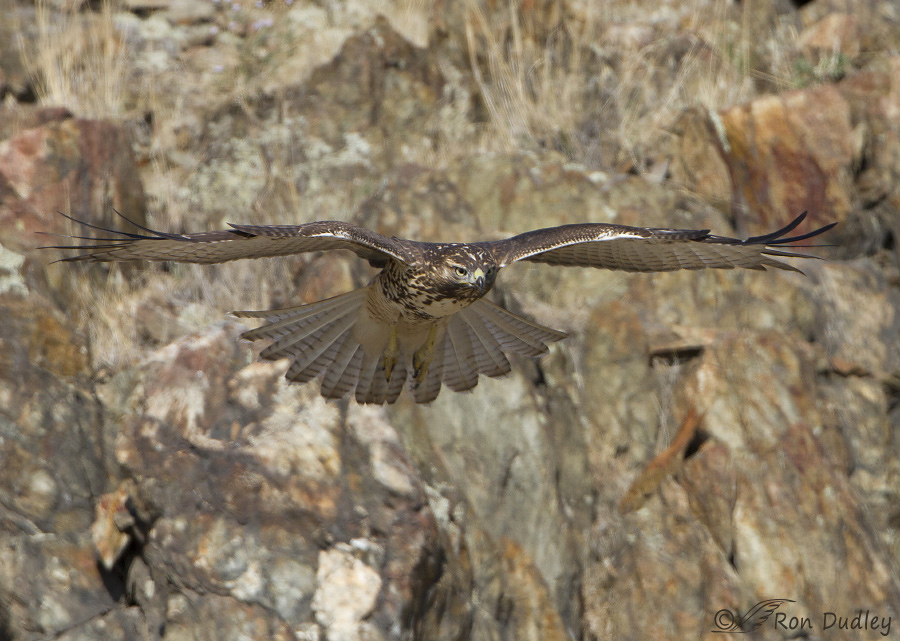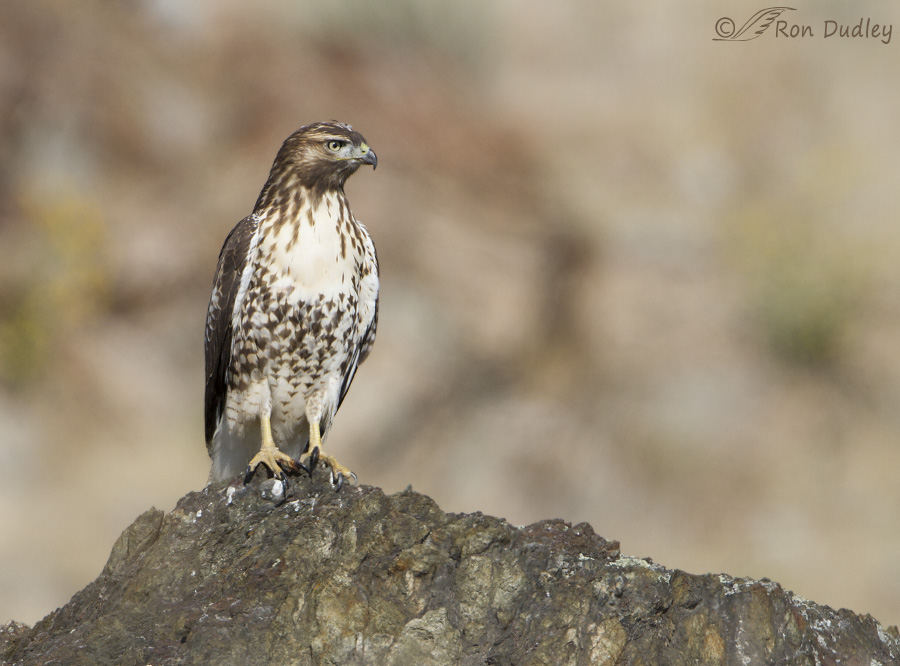Red-tailed Hawks in a wild setting are among my favorite subjects.

1/2000, f/7.1, ISO 500, Canon 7D, Canon EF 500mm f/4L IS USM + 1.4 tc, not baited, set up or called in
A few years ago a couple of juvenile Red-tailed Hawks hung out near Frary Peak on Antelope Island for several weeks. I suspect they were siblings and one of them was quite cooperative for days on end. It preferred to hunt voles from the rocks near the road and became quite acclimated to traffic so I had multiple opportunities with it, though the other bird was much more skittish.
Here the young hawk is scanning the grasses below its craggy perch for prey. I like the tense pose and the natural setting even though a couple of unruly feathers on the top of the bird’s head rob it of some of its dignity.
 1/2000, f/8, ISO 500, Canon 7D, Canon EF 500mm f/4L IS USM + 1.4 tc, not baited, set up or called in
1/2000, f/8, ISO 500, Canon 7D, Canon EF 500mm f/4L IS USM + 1.4 tc, not baited, set up or called in
Here the hawk has launched after prey. The intended victim was very close to the base of the rocks the hawk had been perched on so its gliding flight path was steep – thus the fanned tail. I was pleased to keep focus on the hawk for several shots with the background so close to the bird. Perhaps the hawk doesn’t stand out very well against the similarly colored rocks but that’s actually part of the reason I like the image – it demonstrates the effectiveness of cryptic coloration.

1/2000, f/8, ISO 500, Canon 7D, Canon EF 500mm f/4L IS USM + 1.4 tc, not baited, set up or called in
This time the hawk missed the prey so it returned to another nearby rocky perch and started all over again.
For the last few years Red-tailed Hawks have been uncommon on the island so I often think of these two birds when I drive by the Frary Peak area. I hope both birds survived to mature and breed.
Ron


Redtails are numerous here. They were rather annoying with their persistent calling for parents to bring meals this summer. Like enough already. Worse than the neighbors dog. They nest across my street in a tulip tree. They were the talk of the street.
Magnificent! I see why you liked this youngster with his cooperative posing. I was out early this morning for a bit of birding and heard that unmistakable cry from overhead. A beautiful adult circled a few moments in the morning sun and disappeared. That’s the way to start a day! And viewing your photo of a new buteo is a good way to end the day. Good night!
Even on a (slightly) bad feather day, that bird has more dignity and majesty that I can muster. And beauty.
Great shots, Ron! Love the way the colors blend into the scenery. We tend to have quite a few red tailed in this area. Hope they come back to Antelope Island.
Love the way the colors blend into the scenery. We tend to have quite a few red tailed in this area. Hope they come back to Antelope Island.
Thank you, Judy.
Beautiful bird. It’s crop looks empty so it was very focused on hunting.
Focused it was, April. It wasn’t a very good hunter, being so young, but it sure worked at it.
It is a very critical time in a young raptors life. The parents stop feeding it and it must catch prey on its own. Life in the wild is tough!
What fantastic shots Ron!
Charlotte
I’m glad you like them, Charlotte. Thanks.
I loved the second shot in particular–what you call “cryptic coloration” I call “visual harmony” with just enough definition to focus on the centerpiece–gorgeous !
“what you call “cryptic coloration” I call “visual harmony”
A rose by any other name, Kris! Thank you.
Thank you Ron and Laura for your comment.
As i had said earlier, it is a mystery why our rabbit and vole population is increasing and yet there is little evidence of predators lurking about. Coyotes we hear at night, not every night, but occasionally. Great Horned Owl was heard two years ago, not heard since, etc., the mystery continues.
Dick, we have prey-laden areas where there are no obvious predators too. I suspect that certain times of year there are more areas like that than there are predators to take advantage of them.
I don’t know about voles, but as I understand it, rabbits have a 7 year cycle…of peaking populations then declining. As our coyote populaion has increase, our small mammals like woodchucks,rabbits and voles have decreased….
Vole populations are cyclic too, Patty.
I’ve got a Harris’ hawk, a redtail and a Kestrel who would be delighted to trim your rabbit/vole population
Bring them on!!
To give you an idea as to how tame (plentiful) they are, all but the voles are seen every day; the local Chipmunk runs under my patio chair as I’m sitting in it. If I come out of the back door, two rabbits will lazily scamper to the weeds and the normally quick and shy voles are less so. Now, do I mind, no. But, my garden does and I would much prefer a hawk, fox, coyote or owl have a delicious dinner!
Obviously, they NEED a comeuppance Dick!
One of my favorite subjects and you did an excellent job on these. It’s really nice when you have someone cooperate with you. Excellent job in keeping the flight shot in focus considering the background. Were you using a single AF point or the next step up? I don’t recall the correct term used for center plus 4 surrounding points. Anyway, love these.
Thanks, Frank. I was using the central 5 AF points. That’s nearly always my preference unless I’m shooting a perched bird. Once focus is locked I find it easier to maintain focus on a bird in flight using 5 active points.
The only (occasional) exception is when I have a very large, slow bird in flight up close. Then I sometimes use a single point and TRY to lock focus on the head or eye but that isn’t easy so I don’t do it very often.
Ah, be still my heart! SPLENDID shots and the usual Oh WOW! You captured that outrageous intensity. That’s just SPECIAL!
Dick Harlow, yes they will hunt from any available perch, including buildings. But sometimes, areas with available prey don’t have a resident predator. That’s always amazed me, but it happens. A lot of redtails survive on small rodents rather than taking on bigger prey, probably because they’ve failed at catching the bigger stuff in a big way when they were kids and just never went back to it.
I hope those juvie redtails survived, too. But you know how much I love redtails!
Thank you, Laura. Given your love of red-tails I figured you might enjoy this post.
Very nice shots Ron.
Question – Do you or anyone know whether Red-tails will hunt near buildings (minimal traffic, no kids, no pets) if there are plenty of rabbits on premises or near by?
We have visitations by Cooper’s and a Peregrine, but our Red-tail seems to come (for the last three years) only last part of winter.
It is a mystery to me why we don’t seem to have predators of either rabbits or voles here.
Thanks in advance for any info positive or negative.
Dick, though we have plenty of rabbits out here I seldom (as in almost never) see red-tails hunting them. They seem to prefer small rodents and the occasional snake.
But whatever the prey our red-tails often become acclimated to all the trappings of humanity (including buildings) and hunt near them. Some of our most dense populations of red-tails hunt from power poles right next to Interstate 15 in Davis County. It’s frustrating to drive by all those hawks that I can’t photograph and then find none if them in wilder more accessible places.
And the famous red-tails on the Cornell campus all seem to be hunting from campus buildings as far as I can tell from the images and descriptions I see of them.
This is one magnificent bird. I, too, hope it and its sibling have survived and thrived. And I really like the flight shot, partly because of the cryptic coloration, partly because of the look of intense concentration on the bird’s face. I hope the Red-tails return to Antelope Island.
I do too, Susan – it’s been a long time since I’ve photographed a red-tail on the island.